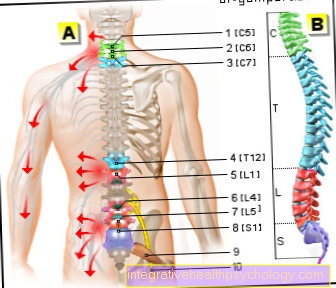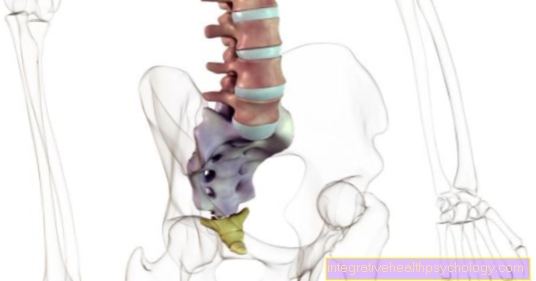Upper abdominal pain
definition
Pain in the upper abdomen means pain of various causes, which are in the upper half of the abdomen can be specified.

Localization of pain
In medicine, the abdomen is divided into four quadrants, drawing a vertical and a horizontal line through the umbilical region. The upper abdomen is thus divided into the right and the left Upper abdomen. The Epigastric region (Epigastrium), in the middle upper abdomen, considered separately. In addition, some patients also Pain in the diaphragm described.
It should be noted that the localization of the upper abdominal pain cannot always be used to determine the cause, as in some diseases the pain radiates and each patient perceives pain differently.
Pain character
Abdominal pain can somatic or visceral be. While somatic pain as strong and stabbing is felt and can be precisely localized, visceral pain is more likely dull and oppressive and hardly localizable. The form of the pain often allows conclusions to be drawn about the cause of the upper abdominal pain.
Abdominal pain can colicky or be persistent. Colic leads to a pain that constantly increases and decreases, which is especially the case when a hollow organ is relocated (e.g. Gallstones, Intestinal obstruction).
Pain can be light to very strong. Often times the severity of the pain is on a scale of 0 – 10 indicated (= visual analog scale), where 0 means to have no pain and 10 means to have the strongest imaginable pain.
In addition, the Upper abdominal pain at night occur. The therapy depends on the triggering cause.
General causes
Certain conditions can cause pain that can be found anywhere in the abdomen can also occur in the upper abdomen. Which includes:
-
Gastrointestinal infections with abdominal pain, nausea, vomiting and diarrhea
-
Intestinal obstruction (Ileus): An intestinal obstruction is caused either by adhesions in the abdomen (e.g. due to scarring after operations), due to an obstacle in the intestinal lumen (e.g. colon cancer) or due to reduced bowel activity (e.g. as part of intestinal inflammation or after operations on the intestine)
-
Perforation: A hole or tear in the wall of a hollow organ (e.g. in the stomach), usually as a result of a prolonged untreated inflammation or an ulcer.
-
Intestinal infarction: This is understood to be a circulatory disorder in the intestine, possibly even with the death of sections of the intestine if the blood circulation cannot be restored in time
-
Poisoning (e.g. with lead)
-
Endometriosis: the presence of uterine lining outside the uterus. This mucous membrane changes with the female cycle and therefore leads to pain.
-
Inflammatory bowel disease: Crohn's disease and ulcerative colitis are the most common.
-
Sometimes the abdominal pain can also be narrowed down to a loop of intestine.
Read on below: Pain in a loop of intestine - And much more
You might also be interested in this topic: Fox tapeworm
Upper abdominal pain - causes
The following diseases can occur in both the right and left upper abdomen:
Kidney stones, Pelvic inflammation
lung infection, Pneumonia (especially if the inflammation is localized in the lower lung areas)
- Abscess (pus cavity) in the area of the Diaphragm
Right upper abdominal pain - typical causes
Among the typical diseases that too right upper abdominal pain lead count:
Inflammation of the gallbladder, Gallstone disease
Small intestine ulcer: Ulcer in the small intestine (mostly in the duodenum) with defects in the mucous membrane of the intestine e.g. from acidification or infection with the bacterium Helicobacter pylori
Liver disease: e.g. Inflammation (hepatitis), thrombosis (Blood clots) or swelling due to backlog of blood (e.g. with heart disease)
Pancreatic disease in the area of the head pancreas
- Diverticulitis: Colon disease with protrusions of the intestine where inflammation develops
Epigastric pain - typical causes:
Diaphragmatic hernia: Parts of the intestine or stomach pass through the diaphragm and into the chest
Esophageal disease: e.g. Inflammation by refluxing stomach acid into the esophagus
Gastric ulcer (see below), Stomach tumor
- Starting from the heart: e.g. Heart attack above all in posterior infarction
Left upper abdominal pain - typical causes:
Gastric ulcer: Gastric ulcer with defects in the lining of the stomach e.g. from acidification or infection with the bacterium Helicobacter pylori
Inflammation of the pancreas
Aortic aneurysm: Expansion or bulging of the abdominal artery with the risk of rupture and bleeding into the abdomen
- Spleen diseases: e.g. Splenic infarction, Rupture of the spleen
Upper abdominal pain after eating
If the upper abdominal pain always occurs after eating, it is often one Inflammation of the stomach lining or a Gastric ulcer the cause. If, on the other hand, the pain occurs mainly when sober up, is more of a Small intestine ulcer to go out. With a ÖDG (Reflection of the esophagus, stomach and small intestine) these diseases can be diagnosed most reliably.
Upper abdominal pain during pregnancy
Also Pregnant women often suffer from epigastric pain. Most of the time, the abdominal pain is harmless and occurs because of Stretching of the abdominal wall and the Displacement of the abdominal organs by the growing child in the womb. In addition to the causes mentioned, upper abdominal pain during pregnancy can also have the following reasons:
Often occurs in pregnancy heartburn with upper abdominal pain. The reason for this is the backflow of Stomach acid into the esophagus due to the changed position of the gastrointestinal tract during pregnancy. Since not all drugs are approved for pregnant women, the gynecologist should always be consulted first.
Hyperemesis gravidarum (Nausea / vomiting during pregnancy): Some pregnant women mainly suffer from in the first trimester of pregnancy with severe nausea with vomiting and upper abdominal pain. These symptoms should be clarified promptly by the gynecologist.
- HELLP syndrome: This is a life-threatening clinical picture at the end of pregnancy, with upper abdominal pain often being the first sign. Also step here high blood pressure, increased liver values and decreased blood platelets together on. The suspicion of one HELLP syndrome should lead to immediate hospitalization.
see also: Upper abdominal pain pregnancy
Diagnosis
1. First of all, the doctor will take a precise history of pain in order to narrow down the possible causes of upper abdominal pain:
-
How severe is the pain (0-10)?
-
How is the pain (dull or sharp)?
-
Where is he strongest? Where is it radiating to?
-
Is the pain permanent? Does the intensity fluctuate?
-
How long has it existed? Was there a trigger for the pain? In which situations is the pain particularly severe?
-
What alleviates or aggravates the pain?
-
Are there any other symptoms?
2. This is followed by the physical examination:
-
Inspection (looking at): Attention is paid to protrusions, skin changes, scars and hernial openings.
-
Auscultation (listening): Are the bowel noises normally present?
-
Percussion (tapping): Is there air or liquid in the abdomen?
-
Palpation (palpation): can indurations be felt? The situation is particularly threatening if, in addition to abdominal pain, there is tension in the immune system. I.e. if the stomach is "hard as a board" when examined. In this case a doctor should be consulted immediately.
-
Rectal examination (palpation of the anal area): In the case of abdominal pain, the rectum is often palpated to e.g. Recognize bleeding as the cause of the abdominal pain.
3. The blood sample should provide evidence of inflammation and impaired organ functions (liver, kidneys, pancreas, heart). A pregnancy test should also always be performed in women with abdominal pain.
4. In the case of upper abdominal pain, a heart attack should always be excluded with the help of an EKG.
5. Ultrasound examinations / X-rays or computed tomography are used to immediately identify or exclude acutely life-threatening clinical pictures.
Read more on the topic: Ultrasound of the abdomen
6. Further examinations: gastroscopy, colonoscopy, visualization of the biliary tract (ERCP), etc.
therapy
In order to be able to treat the upper abdominal pain adequately, the cause must always be clarified first. In particular, it is important to recognize or rule out life-threatening diseases immediately in order to decide whether, for example, an operation is immediately necessary.
Urgent indication for surgery: Perforation of a hollow organ or aortic aneurysm, intestinal infarction, Rupture of the spleen
Does not require acute surgery: Aortic aneurysm (as long as there is no risk of a tear), diaphragmatic hernia, gallbladder inflammation / gallstone disease, abscesses
Conservative treatment Temporary abstinence from food or light food already leads to an improvement in most other causes of upper abdominal pain.
In addition, i.a. the following therapy principles applied:
- Administration of antibiotics for inflammation (inflammation of the pancreas, diverticulitis)
Acid blockers in the case of inflammation of the stomach / esophagus
- Special therapy a.o. With Cortisone in inflammatory bowel disease





























